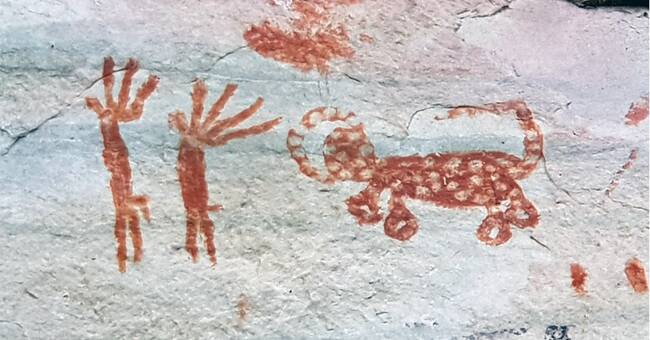The discovery was made in a part of the Amazon where researchers have previously found images on rock walls, painted with red doll color.
During an expedition last year, thousands of new images were found along a stretch of just over a mile in an area called La Serranía La Lindosa in northern Colombia.
Some are images of animals still living in the rainforest: caimans, monkeys and tapirs, among others.
Others show animals that lived during the last ice age, but are extinct today.
A megafauna with mastodons, ancient elephant relatives, extinct llamas, giant sloths, ice age horses and strange three-toed ungulates with proboscis.
- The animals are so realistically presented that we can clearly recognize all species.
They agree very well with finds from bones from the ice age, says José Iriarte, an archaeologist at the University of Exeter in England, and one of the project leaders.
Grass steppe
The animal images, and the objects that humans have left behind in caves in the area, allow researchers to establish that the oldest paintings were created about 12,600 years ago.
The paintings give the researchers a clear picture of what the area, which today is a dense rainforest, looked like at that time.
- They show that this part of the Amazon must have contained both forests and large grasslands at this time, says José Iriarte.
First inhabitants
On the rock walls there are also pictures of the artists themselves.
They are depicted in hunting scenes or when they fetch food from the plant kingdom.
In some cases, they have also put their own handprints in the rock.
The researchers interpret some of the motifs as scaffolding that has been erected against the rocks to reach the highest points.
José Iriarte believes that the people who painted on the mountainside belonged to the very first groups of hunters and gatherers who migrated into the Amazon from the north.
His theory is that the creation of the images was a part of their religious life.
Do not eat the megafauna
Most of the large animals depicted disappeared at the end of the ice age.
Climate change and hunting are usually cited as the explanation behind the extinction.
But strangely enough, the researchers find no bones from the megafauna in the human remains.
- They seem to have ingested everything they came across, plants, fish, and animals such as caimans, deer and snakes - but the large herbivores are completely missing in the material from La Serranía La Lindosa.
It seems that they wanted to paint them, not eat them, says José Iriarte.

